
The Dee River Ranch installation is “a showcase for the most sophisticated irrigation technologies available today,” says Randy Wood, vice president of sales and marketing for Zimmatic. “It’s a completely integrated irrigation system that will meet their current and projected future needs.
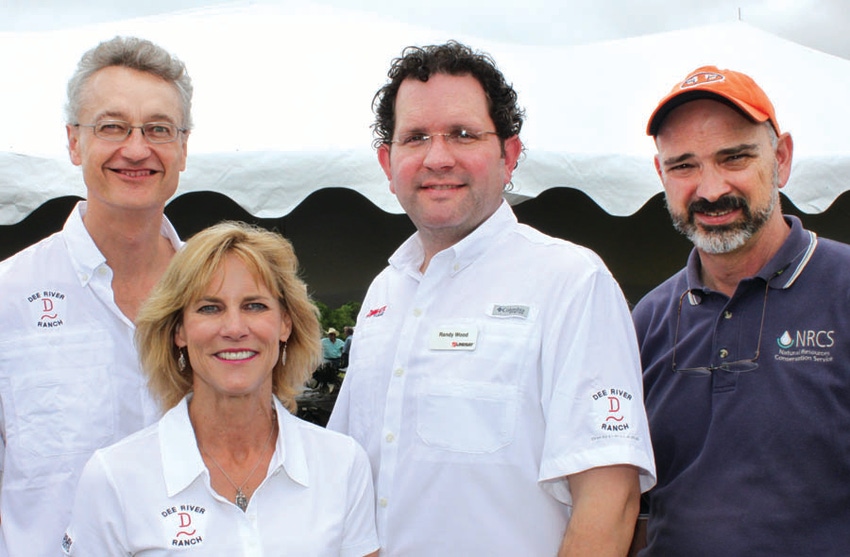
On the 10,000 acre Dee River Ranch, located along the Mississippi-Alabama state line near Aliceville, Ala., the future of irrigation technology is in place today.
From a 120-acre reservoir to collect winter/spring rains, to a computer-controlled 12,500 gallons per minute pumping station that can deliver irrigation water tailored to crop, weather, and soil conditions for up to 15 center pivots, to a super-fast electronic “cloud” that allows people and devices to communicate with each other over a 20 square mile area (or anywhere in the world with Internet access), the state of the art system is designed for maximum automation, using the minimum amount of water to get maximum results, with as little energy consumption as possible.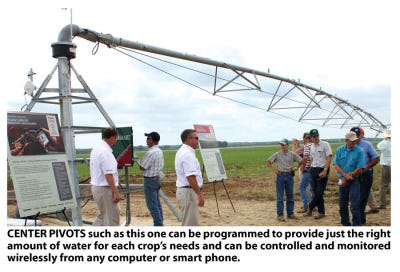
“We’re dedicated to conservation and environmentally friendly farming,” said Annie Dee, who with her brother, Mike, runs the operation whose ownership includes 10 other Dee brothers and sisters.
“This project will help us to reduce risks and make our farming operation more efficient and sustainable,” she said at a recent field day to dedicate the system and give the ag community a look at the technology it incorporates. An estimated 300 persons from Alabama, Mississippi, Tennessee, Georgia, and other states attended the event.
“Agriculture and the Dee family go back to our great-grandfather who farmed in Iowa,” she said. “We later had an operation Florida, which was sold, and now we have fourth and fifth generations farming here, with sixth generation children on the ground.
“What’s important to us is sustainability, conserving land and water resources. We’re growing corn, soybeans, and wheat, and this year — even though I said we’d never grow it again — we’ll be back in cotton.
“We’re pleased to be partnered with the Lindsay Corporation in this outstanding irrigation project, and their various divisions that were able to give us a tailor-made package system.”
Mike Dee said, “our goal is to go beyond sustainability — each year, we’re putting money into improvements, technology, and cropping programs that use minimal resources and put as much back into the land as possible for future generations.
“Here in the rain belt, we have abundant water, but unfortunately it too often comes at the wrong time. Rather than letting winter and spring rains escape, we want to capture and use that water for crop production. Reservoirs such as the one we have here are another way to capitalize on opportunities by catching and using rainfall that would otherwise just run downstream.
“A lot of smart people have been a part of designing this system, and we believe the long term benefits of this kind of technology can be enormous for U.S. agriculture.”
Showcase of irrigation technologies
The installation is “a showcase for the most sophisticated irrigation technologies available today,” said Randy Wood, vice president of sales and marketing for Zimmatic. “It’s a completely integrated irrigation system, utilizing the knowledge and expertise of all the Lindsay divisions, for a system that will meet Dee River Ranch’s current and projected future needs.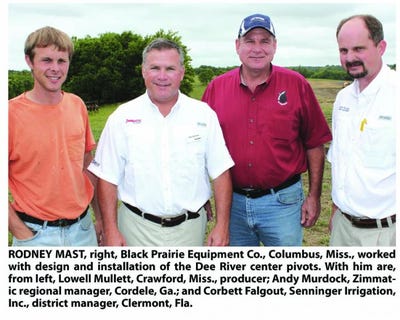
“We’ve been building durable, rugged irrigation systems since the 1950s that are operation all over the world. Some 40- and 50-year old systems are still reliably operating every day. Combined with the high tech Growsmart control panels, these systems offer growers ease of use, reduced risk, and increased profitability.
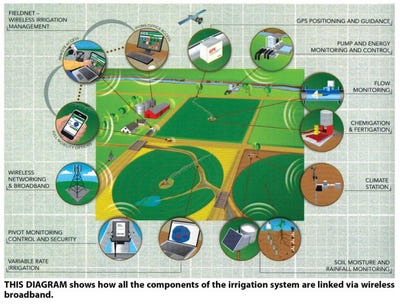 “In addition to providing optimum application rates and high efficiency, these engineered sprinkler systems have chemigation and fertigation capability to extend capital investment and reduce cost per acre. Programmable controls increase efficiency and improve yields by allowing the right amount of irrigation at precisely the right time of the crop’s growth cycle.”
“In addition to providing optimum application rates and high efficiency, these engineered sprinkler systems have chemigation and fertigation capability to extend capital investment and reduce cost per acre. Programmable controls increase efficiency and improve yields by allowing the right amount of irrigation at precisely the right time of the crop’s growth cycle.”
The Dee River system includes five new Zimmatic center pivots, for a total of seven on the ranch, in lengths from 988 feet to 2,023 feet, covering about 1,500 acres of corn, soybeans, and cotton. It utilizes GPS satellite positioning for precise pivot position and end gun control. All systems have Growsmart FieldBoss control panels and FieldNet Wireless Irrigation Management technology to control all pumps and pivots through an ezWireless broadband Internet network.
John Atkinson, agricultural business manager for Watertronics, a Lindsay company, said the pumping stations were custom engineered and pre-tested, based on the ranch’s specific needs, field conditions, and irrigation network design.
"The main pumping station has a 12,500 gallons per minute capacity, using five 150 horsepower vertical turbine motors; it can deliver water to 15 pivots. Water is pumped from the 120 acre reservoir, which can store 1,700 acre feet of water, through below-ground pipes ranging in diameter up to 30 inches.
“The transfer pump station has a 7,500 gallons per minute capacity, using three 100 horsepower vertical turbine motors to deliver water from a nearby creek to the reservoir. Water is pumped over 3,000 feet, up a grade of 50 feet.
“Watertronics variable frequency drive technology is used in both pumping stations, and both are controlled and monitored by FieldNet Wireless Irrigation Management. System status is transmitted every minute over the wireless network and can be monitored and controlled by computer or smart phone anywhere with Internet access.”
Precision variable rate irrigation
The system will provide precision variable rate irrigation for all pivots, Atkinson says. Each sprinkler can be programmed to turn on/off or pulse at a specific rate, depending on crop, terrain, or obstacles.
“You can select the pivots you want to operate and the system will determine all the variables to provide just enough water, with just the right amount of pressure, to get the job done. It has built-in redundancy and built-in diagnostics to provide alerts to potential problems.
“It constantly monitors and keeps a record of system performance and power consumption. The variable frequency drives reduce energy consumption and cost by automatically adjusting to the system’s pressure and flow requirements, always operating at the optimum level, providing surge-free pressure regulation that can cut energy costs by as much as 25 percent.”
Brad Kincaid, vice president and general manager of ezWireless, also a Lindsay company, said Dee River uses “a cutting edge wireless system that links all farm systems: pumping station, pivots, vehicles, office — even 4-wheelers and Gators. Everything at Dee River is connected via an 80-foot tall base station tower that sits atop a high hill, offering 20 square miles of coverage, with broadband speeds up to 300 mbps (which is 10 to 100 times faster than the average home Internet connection).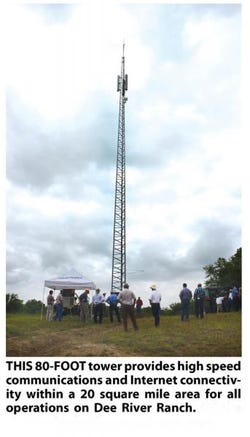
Palm-size mobile wireless units that plug into a vehicle cigarette lighter create moving wi-fi hot spots for pickups, ATVs, tractors, combines, or other vehicles.
The system also supports e-mail, Web access, servers, and wireless printing for any device on the network, or via smart phone or laptop anywhere in the world with Internet access.
“We’ve created a full service remote wireless network and broadband Internet system in an area with limited or no cell phone coverage,” Kincaid said. “It offers extremely fast, reliable communications using hardware that is proven in harsh outdoor environments.
“It’s infinitely expandable, and can include video surveillance cameras and recording devices, soil moisture probes, weather stations, and other digital devices.”
Andy Murdock, Lindsay Irrigation regional manager, said the company’s center pivots on Dee River include the 9500 series, “our heaviest duty machines.” Rodney Mast at Black Prairie Equipment Co., a Lindsay dealer at Columbus, Miss., handled system design and installation.
All the center pivots have GrowSmart Field Boss control panels, which offer automated control and monitoring of all systems, and allow programming of irrigation events with precise patterns and amounts that can be monitored and controlled wirelessly by computer or smart phone.
Savings in energy, labor, and time
“The ability to set and manage equipment remotely means fewer trips to the field, saving fuel, labor, and time,” Murdock said. “Dee River can control and monitor all pivots remotely, and get real time text message alerts on any cell phone about system performance or potential problems.
“There is a user friendly Web portal that provides a quick view of every pivot, including location, status, and water usage. A full screen map provides a quick and easy way to monitor the entire farm and verify status of every machine at once. The system proactively notifies you of any potential issue or problem, allowing you to manage the exceptions.”
John McMillan, Alabama Commissioner of Agriculture and Industries, said the Dee River project “demonstrates how technology can be utilized to increase crop production, while conserving water and promoting sustainability.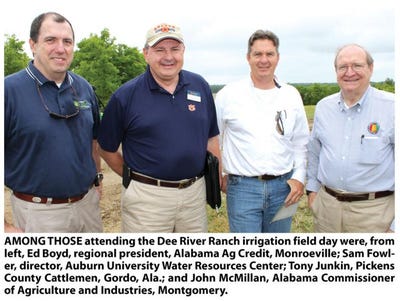
“Alabama is well-positioned as a key player in the nation’s agriculture. We have 2.5 million acres of prime farmland, much of which can be irrigated, and we have abundant surface and groundwater resources. An Alabama Geological Survey shows 33.5 trillion gallons moving through 14 river basins and the coastal drainage area. In our 19 aquifer systems, our average 56 inches of yearly rainfall provides an equivalent of 145 million acre feet of water.”
With technology and irrigation, “crop production can be more certain,” McMillan said.
“The economic impact of agriculture in our state is enormous, but there is potential for even greater benefit. We have huge poultry and beef industries, which need tremendous amounts of feed each year, yet we’re now growing only 10 percent of the corn that we produced in 1950. Today’s total corn production in Alabama would feed our poultry flocks for only five days — just look at the additional potential to supply that one industry and keep more dollars in Alabama.”
There are issues and challenges in moving toward greater utilization of irrigation, McMillan said, including capital access and cash flow. “Much of our farmland is absentee-owned, and it sometimes is difficult to convince these owners of the value of such a long term investment.”
He noted that the Alabama Universities Irrigation Initiative, a collaborative effort that is part of a $280 million national program to finance on-farm reservoirs, is now under way, and that the Alabama legislature has created a Joint Legislative Committee on Water Policy and Management to develop a water management plan and recommend to the governor and legislature a course of action to address the state’s long term and short term water resource challenges.
“This will include a comprehensive database on water issues, and a comprehensive water plan, to be submitted by December 2013,” McMillan said.
Dennis Brag, who farms several thousand acres of cotton, corn, and soybeans in northwest Alabama near Huntsville, said areas east of the Mississippi River “are blessed with abundant water resources. Our issues aren’t so much about water shortages, as in the West, but rather a shortage of creativity in using the water resources we have. Finding ways to make the best use of resources — that’s how agriculture and a state can prosper.”
When considering an investment in irrigation, Bragg said, it’s important to know the laws involved: Who owns the water — the individual who owns the land, or the state?
“A few years ago, I paid a high-priced lawyer to break down the law into layman terms.”
Most laws are based on riparian rights, he noted, with ownership of water tied to ownership of the land, and the owner having a right to “reasonable use” of water flowing through his land.
“There are many variables in ‘reasonable,’ but state law lets the owner decide what constitutes reasonable use, and Alabama’s statutes allow entrepreneurs space to do what’s needed,” Bragg said.
About the Author(s)
You May Also Like



